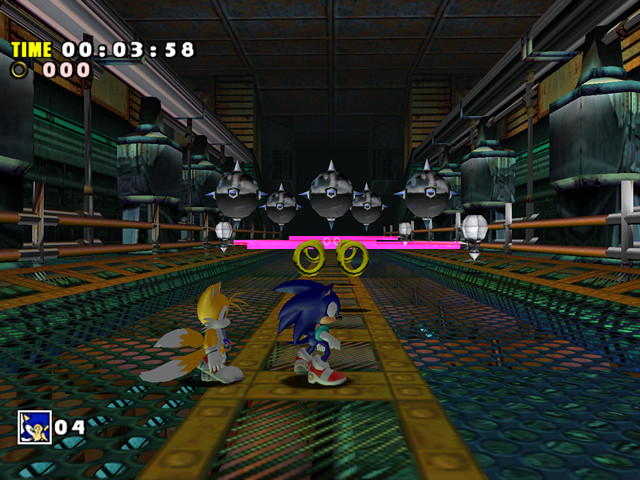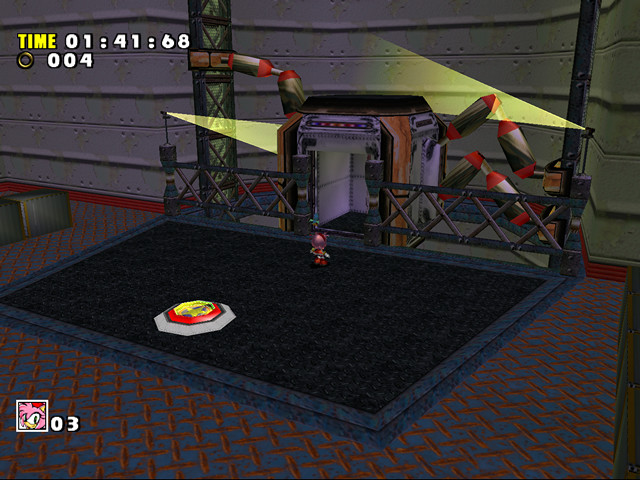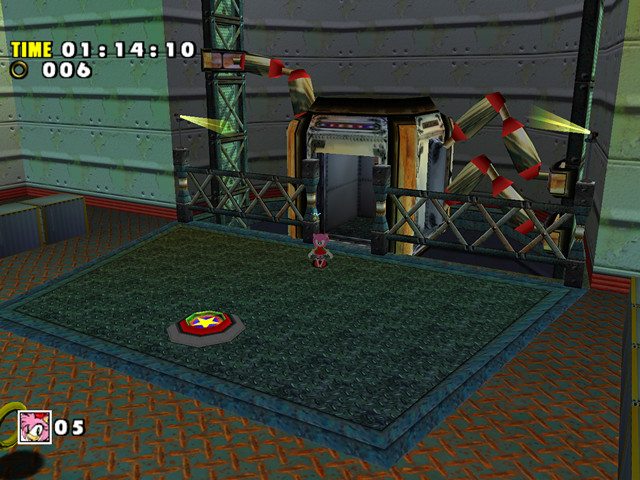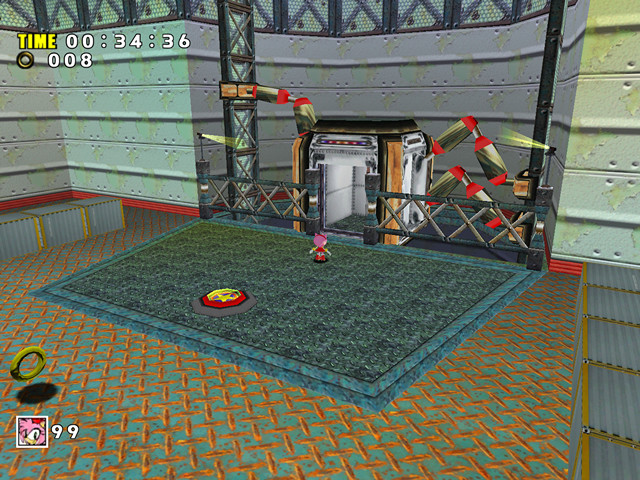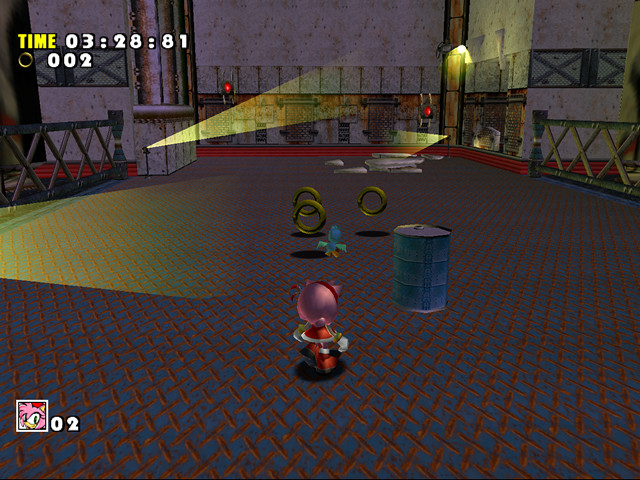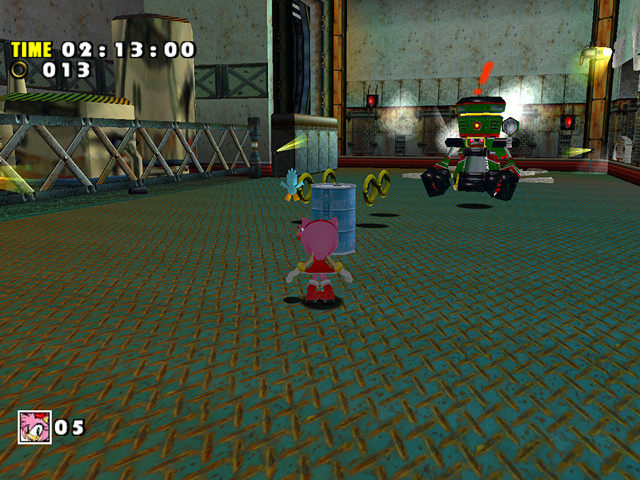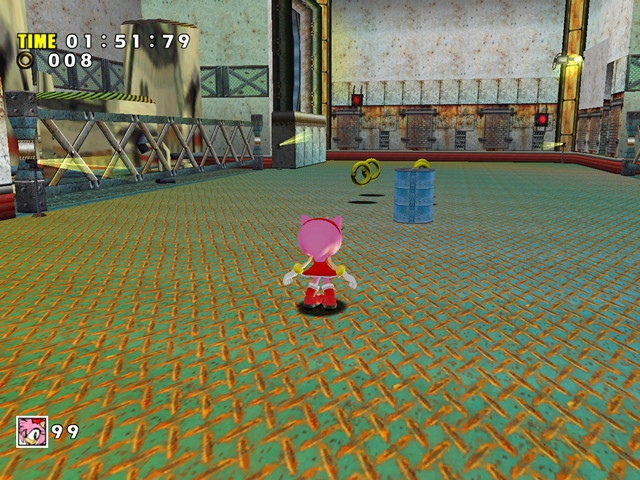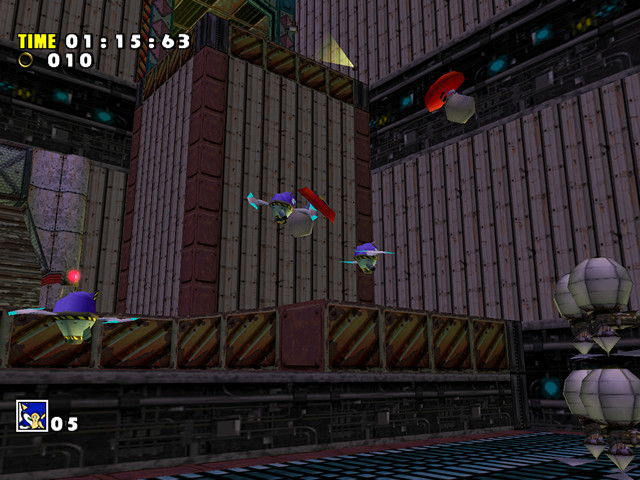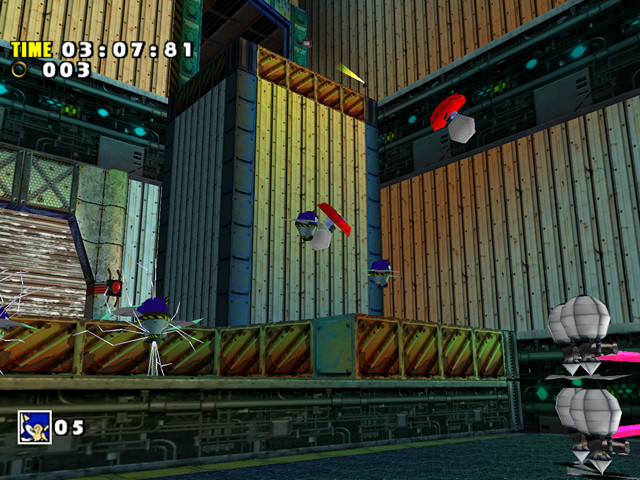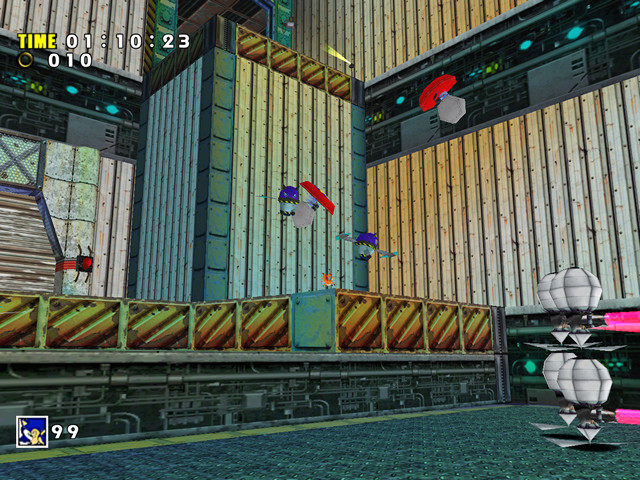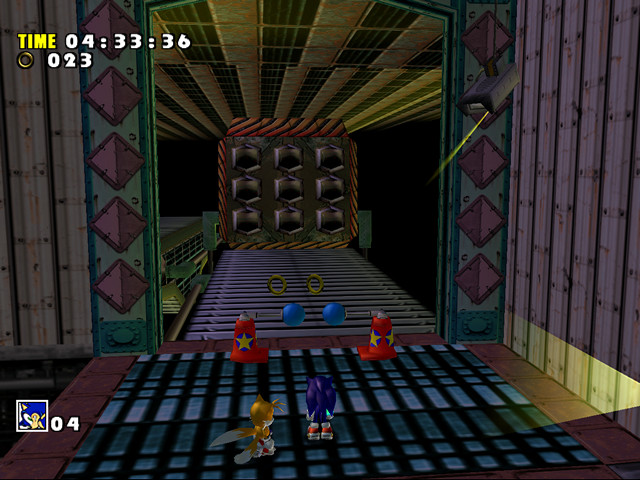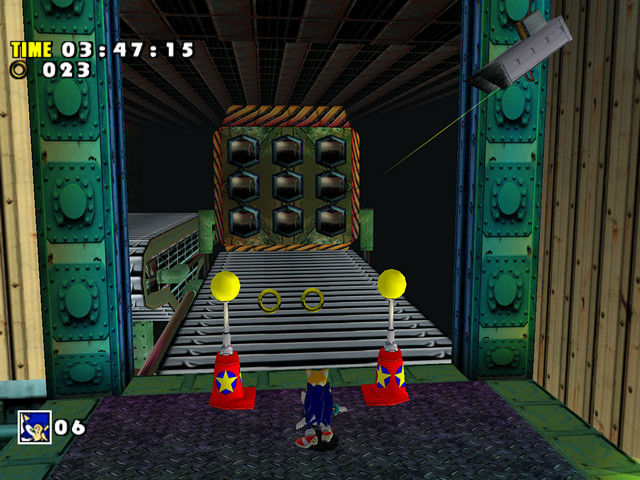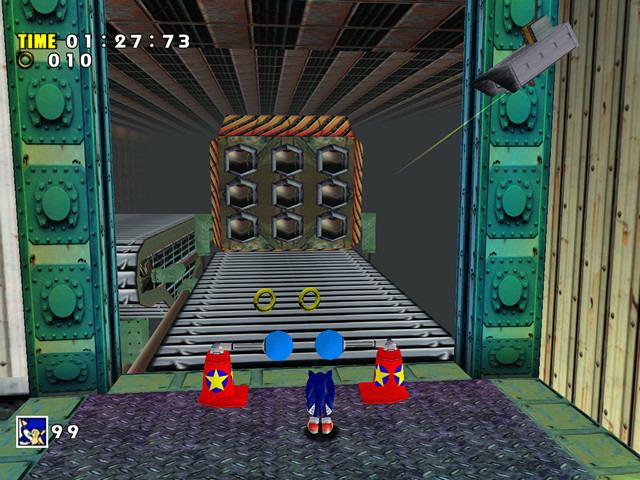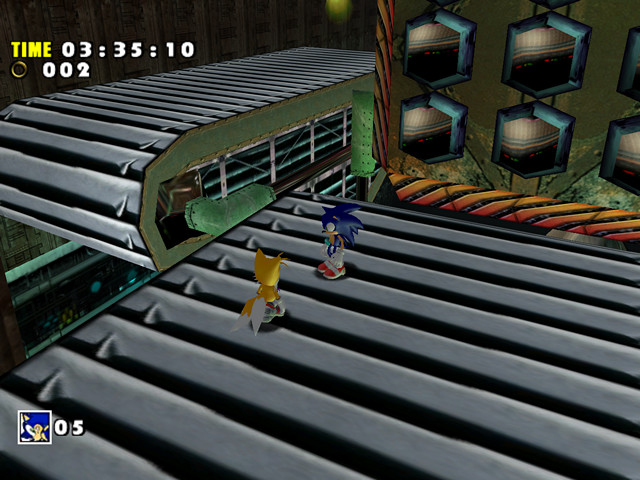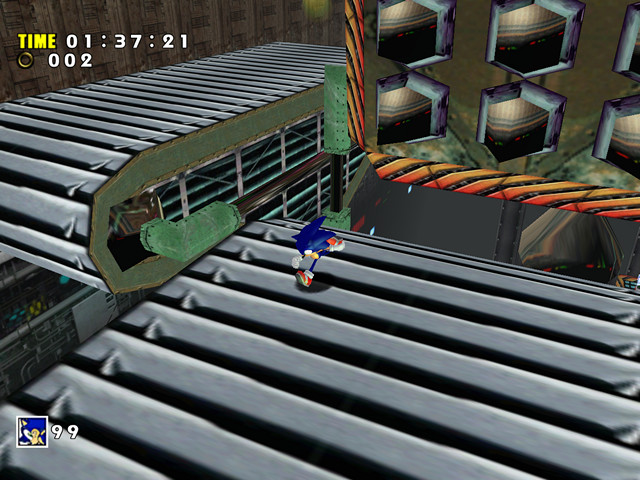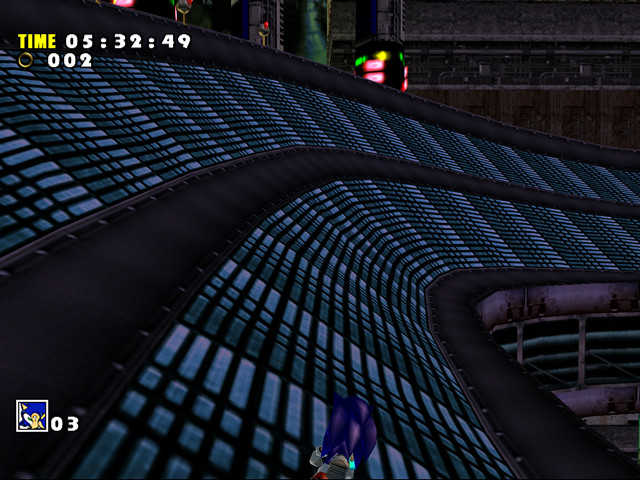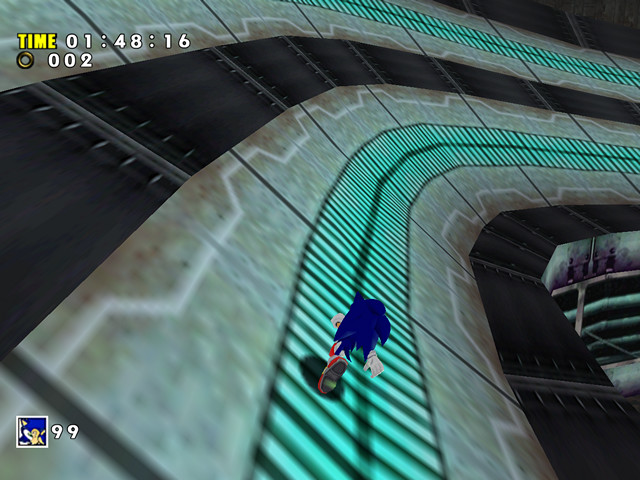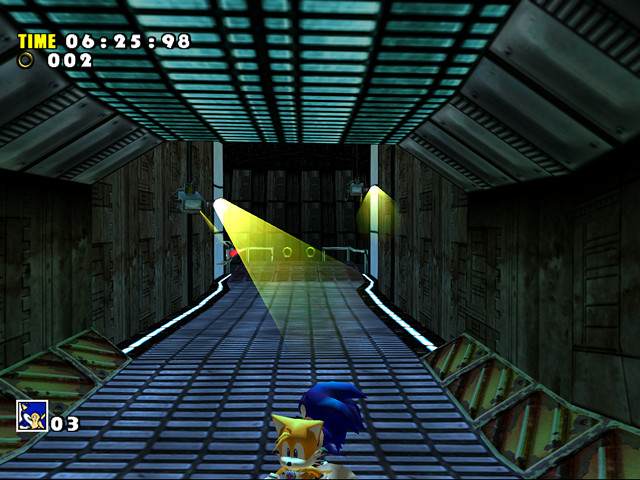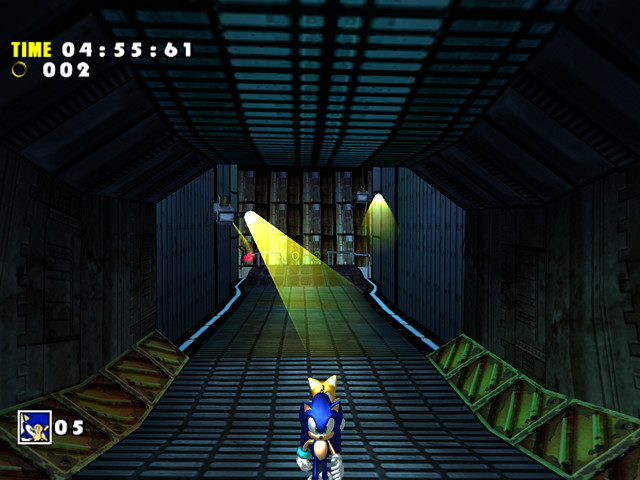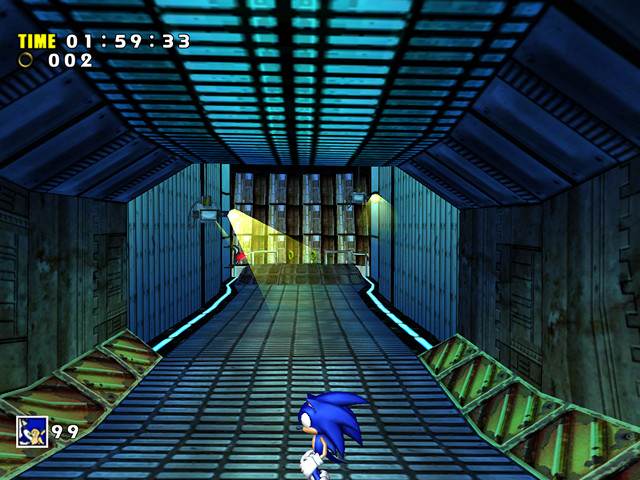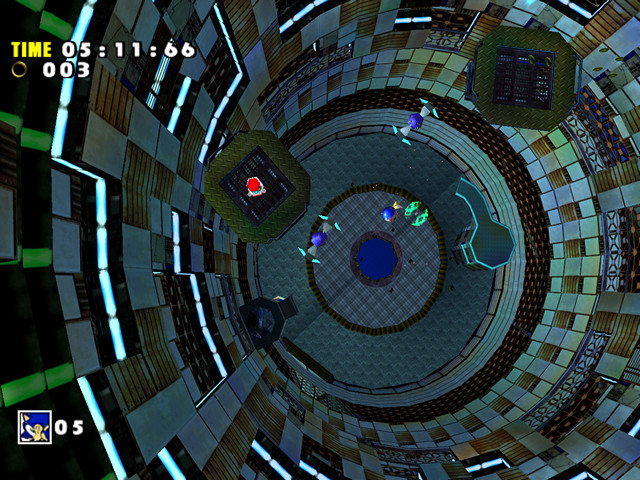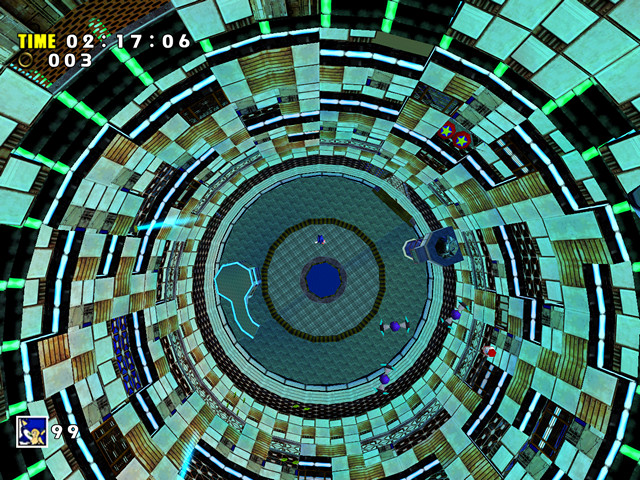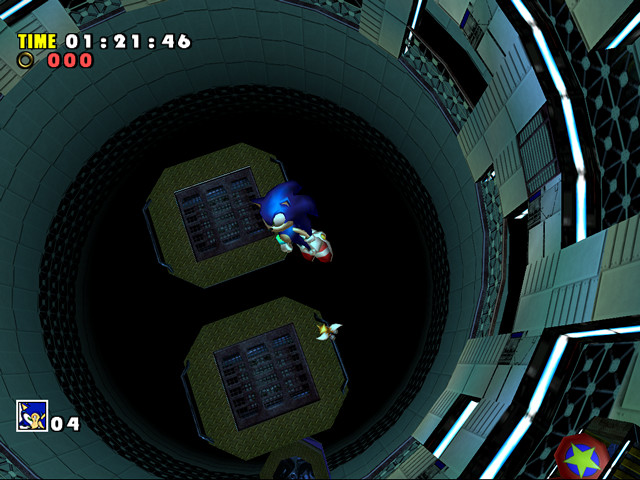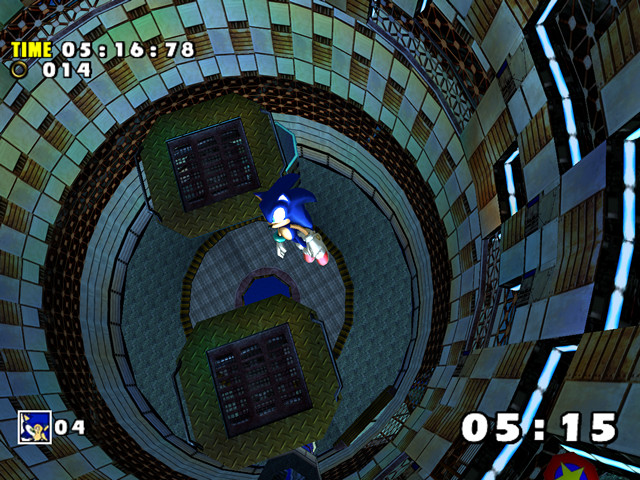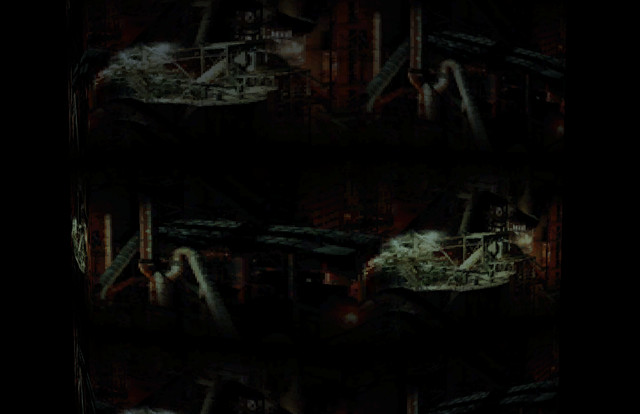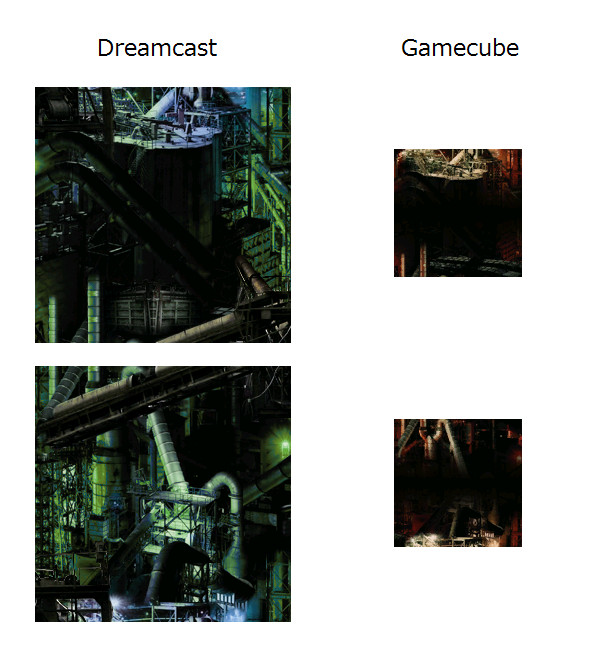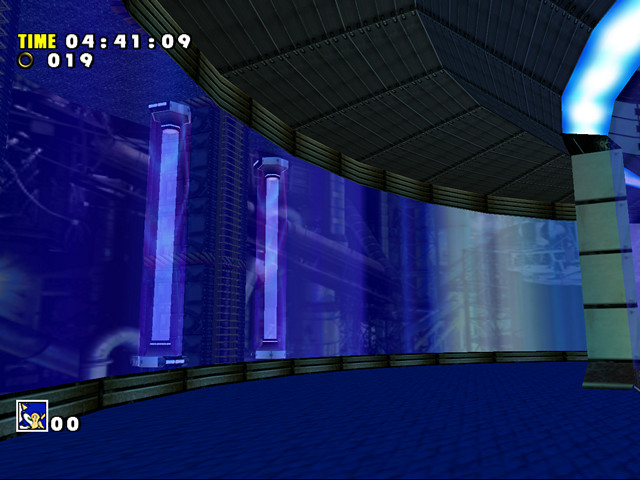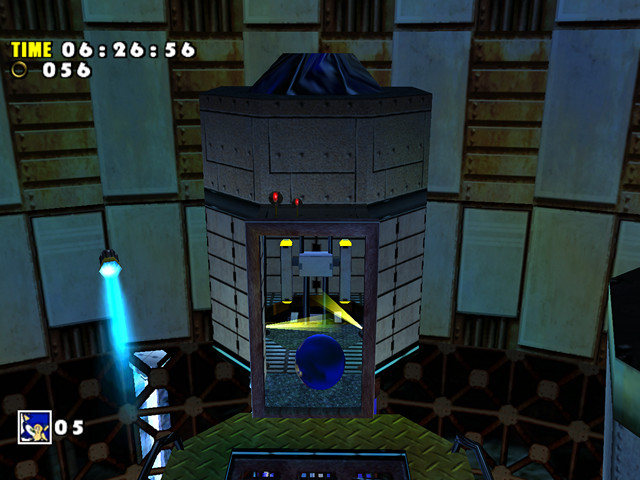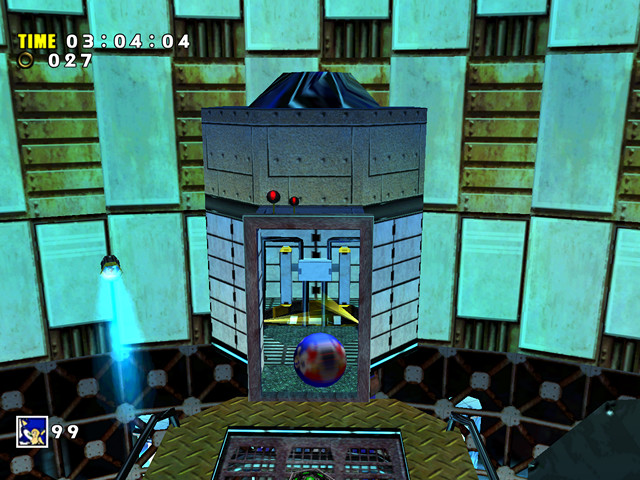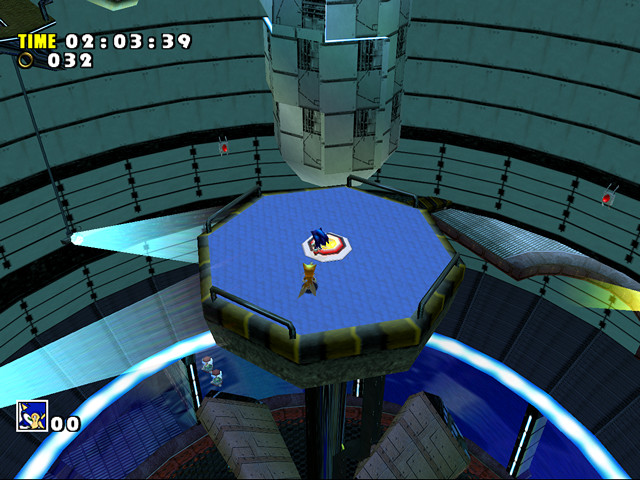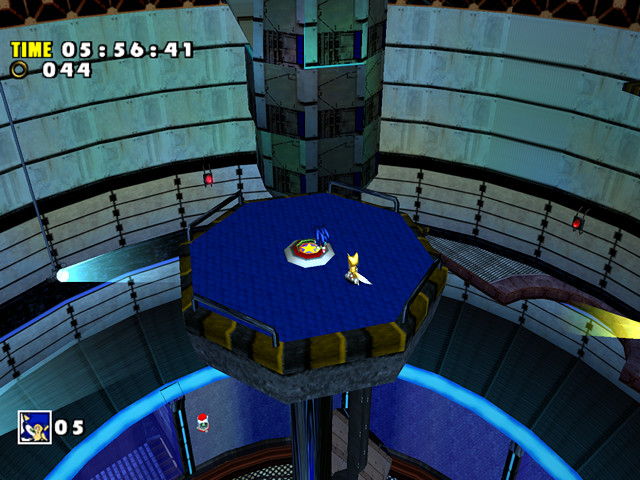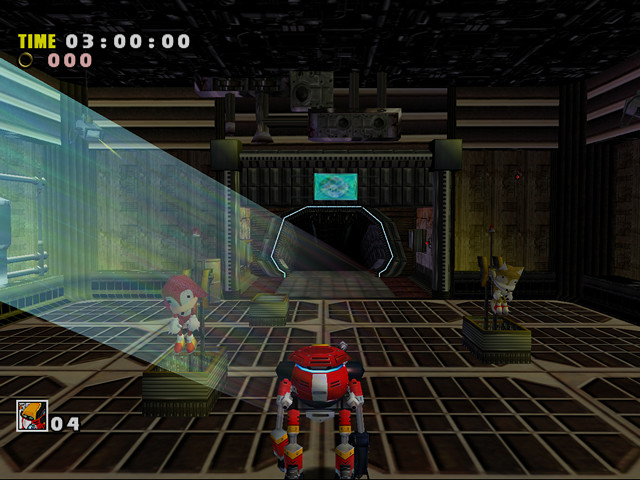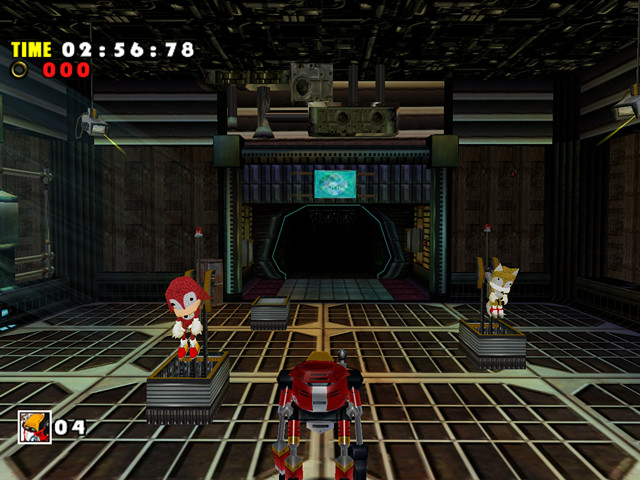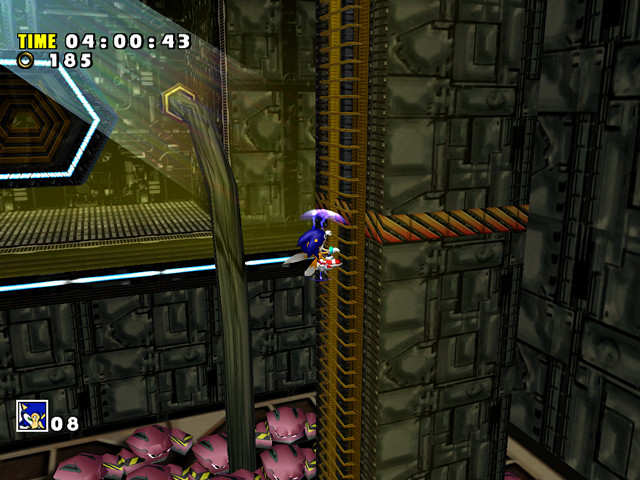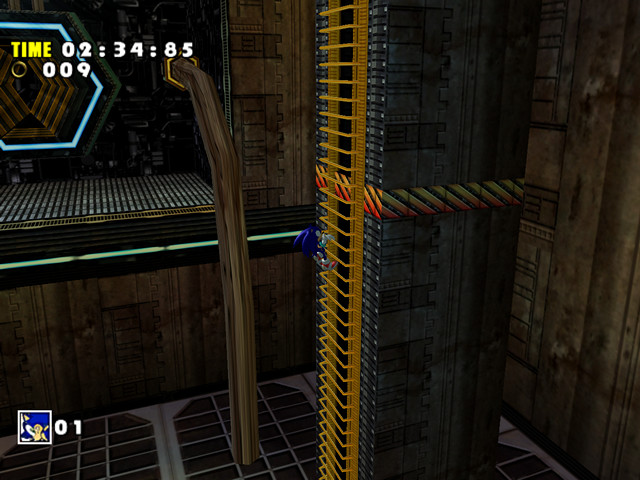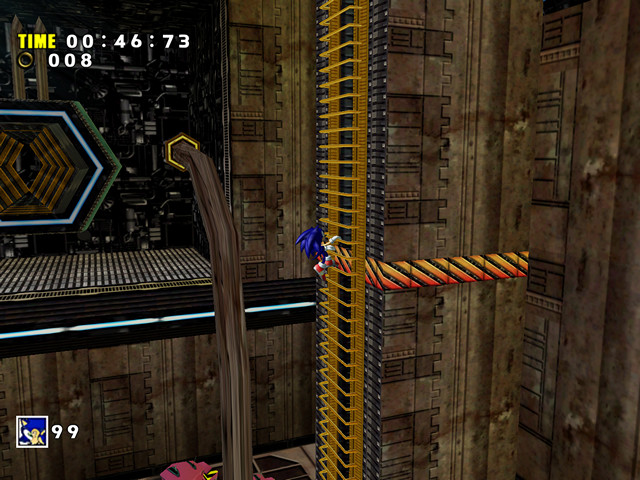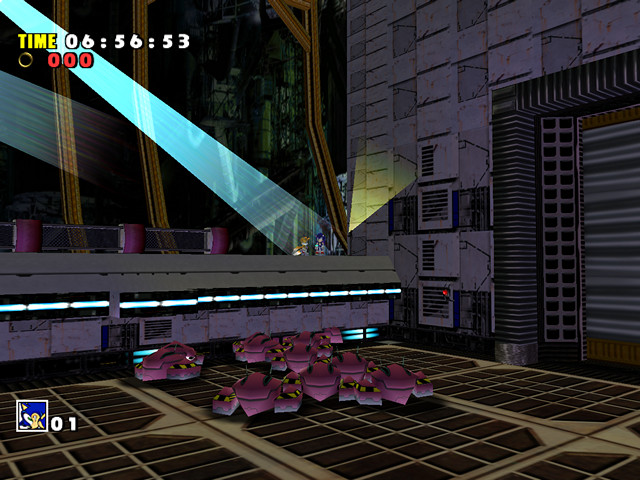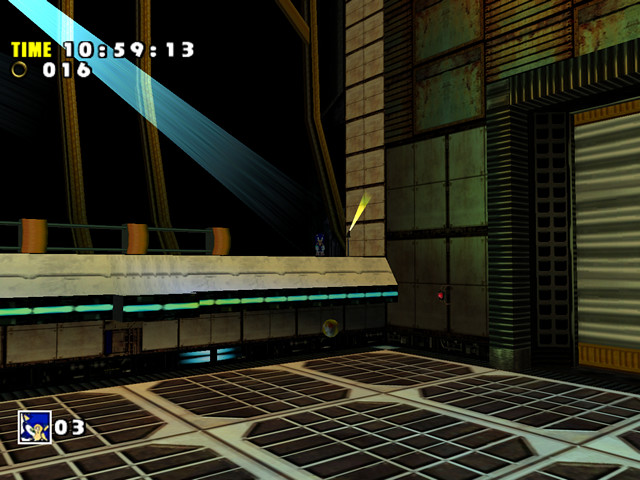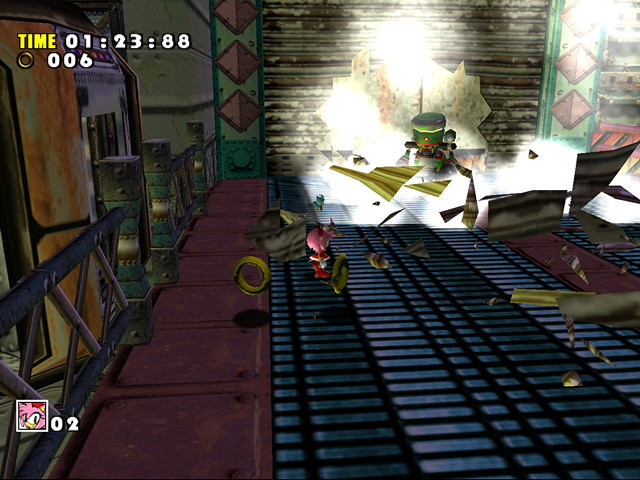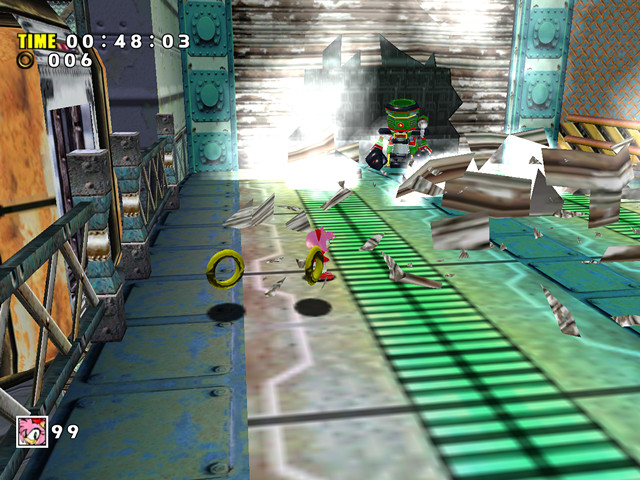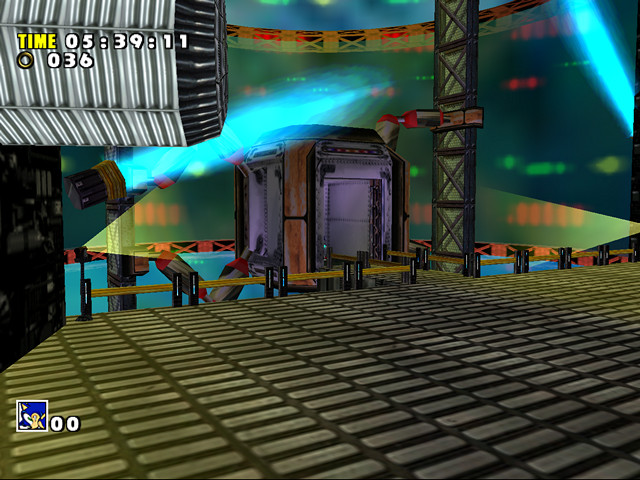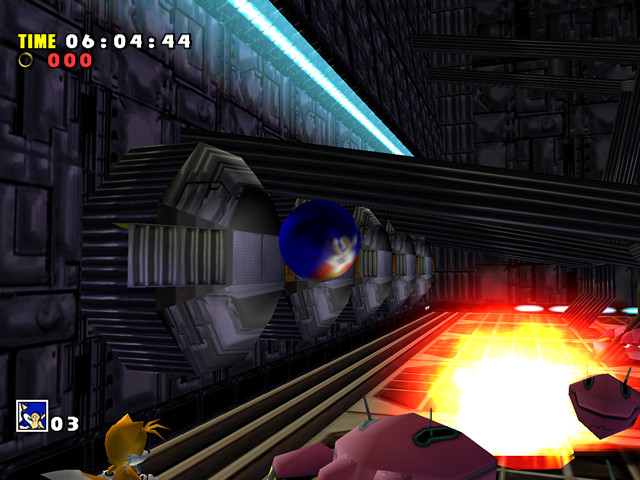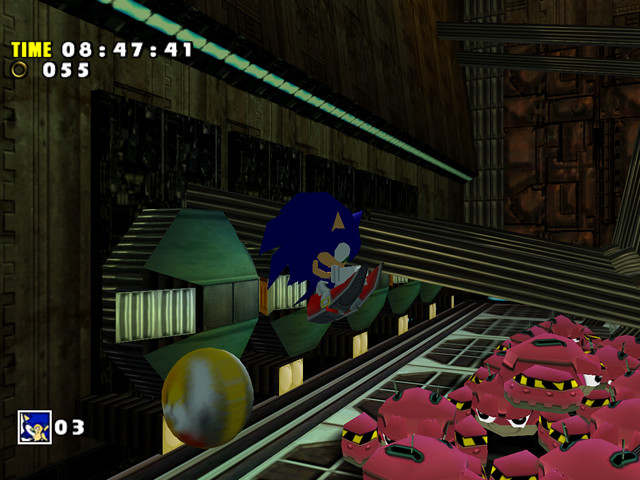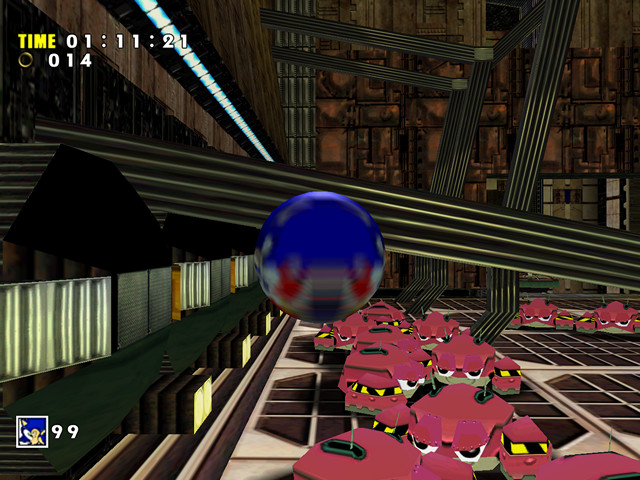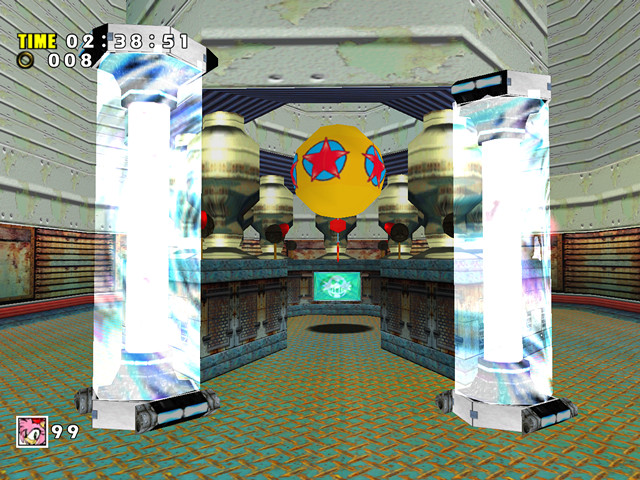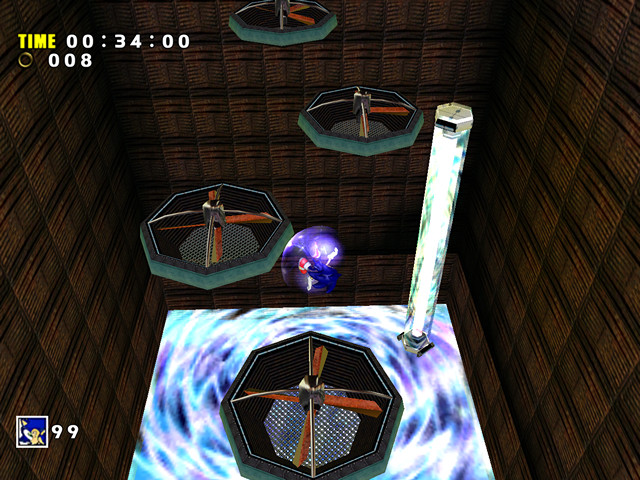If there was a “top 10” list of SADX downgrades, Final Egg would probably be #1. This level suffers from removed lighting, bad fog settings, missing effects, missing object animations, new bugs introduced in SADX, loss of transparency in some level pieces, broken models that wash out backgrounds and poor texture quality. Let’s compare the levels side by side to find out what’s been lost in the transition.
The starting location reveals a different lighting setup. Although the textures have similar design, the SADX version of the level loses the original’s colors and makes it dark green. Dark green would’ve been fine in this level perhaps, but the original’s color variety was removed in favor of colors that are already abundant across the game. Speed Highway and Casinopolis also have green vertex colors. The lighting on Sonic is also dark green in this level, which is a nice change because SADX character lighting seldom matches the environment. The Egg Keeper is missing (although it comes back in the Steam version), and the PC version adds grey fog that doesn’t fit the level too well – black would’ve worked better.
The lasers look different in SADX. Their models are the same in all versions but SADX is unable to render their brighter inner layer properly, making them look like a dark purple line. Rearranging the model hierarchy was enough to restore the original look of the lasers.
The little standing lights are broken in all ports. On the Dreamcast, they consist of one light (vertical or horizontal) that rotates as you walk around it – a subtle effect that enhances the atmosphere of the level. In SADX, the lights have both the horizontal and vertical meshes, making it look strange with two layers, they don’t vary in size and are completely static – they don’t react to camera or player movement.
| Dreamcast | Gamecube |
|---|---|
The rotation effect was subtle, but the loss of light size adjustment is noticeable in areas like these:
The Dreamcast version has more complex lighting on enemies and objects in this level, much like in the rest of the game. The SADX redesign of this particular area compensates for the removal of lighting with vertex colors, which add more lighting detail compared to the flat look of the original (object lighting is simpler, however). The PC version’s lighting is brighter and more washed out:
The ceiling in this and many other areas has lost the yellow light, but the objects and the walls have vertex colors. Again, dark green is the most used color, which takes away from the color variety of the original game. The fog in the PC version doesn’t help the atmosphere:
The loss of lighting is noticeable on objects like conveyor belts, and if you look closely you can see loss of texture quality, which is particularly noticeable in the PC port:
This area near the end of Act 1 has received a new texture, which looks lower quality than the original:
Act 2 has vertex colors that aren’t all dark green, which is a good change. The start area looks darker on the Gamecube and brighter on PC, but fog settings aside it doesn’t appear to have been downgraded:
However, SADX added a bug that allows you to spindash backwards and fall through the level, which you coudn’t do on the Dreamcast. This bug was never fixed in later ports.
| Dreamcast | Gamecube |
|---|---|
All ports have changed fog settings for this level, which makes the bottom of the level visible from above. The Dreamcast version had thick black fog obscuring this area, but in the ports you can see the characters walking around at the bottom after they die:
Here’s another example of this problem. The fog in the original version also enhances the overall look of the scene, although the Gamecube version would have ended up looking just as good (if not better) if it had proper fog settings for this area:
The high-speed sections that take you through blue glass tubes are less impressive in SADX. Let’s have a quick look at the first one:
| Dreamcast | Gamecube |
|---|---|
There are several problems with the SADX redesign of these tubes:
- The blue glass pieces were redesigned to be less transparent, so you barely see anything through them in SADX.
- The UVs on those blue glass pieces were adjusted to make the environment mapping effect less prominent. The tubes are less shiny/colorful as a result.
- The multi-colored tubes have been removed in the areas where they overlapped the glass, and they are also not as bright in the areas where they still remain. The whole scene looks darker and less colorful as a result.
- The large background object behind the glass was adjusted (deliberately) to be darker and more washed out, so you can barely even see it. The texture itself is also darker, lower resolution and has less detail.
Here’s the second section, at the end of which you can see the washed-out background closer:
| Dreamcast | Gamecube |
|---|---|
Here’s what the background object appears like in fullbright (no lighting) if you look at it from the start coordinate (we can do that thanks to the hacking tools made by MainMemory and other talented SA1/SADX hackers):
And here’s what the textures for this object look like (using Gamecube textures; the ones used in the PC port are the same but recompressed):
Not only are the Gamecube textures 4 times smaller (half the resolution) than the originals, but they also have the middle part blackened out. If you look closer you’ll notice that the Gamecube textures use the same artwork as the original Dreamcast textures, but with altered colors and rearranged pieces. Interestingly the original Dreamcast textures are still in the files. This particular level piece looks darker and washed out even with Dreamcast textures because of added dark vertex colors. The UVs also don’t seem to work well with the Dreamcast texture. While the resolution downgrade could have been done for performance reasons (but let’s remember that this is supposed to be an “enhanced” port), there is no way the added dark vertex colors and all the editing were accidental. The developers deliberately reworked this level to make it look uglier.
This area was also downgraded with washed out background and simplified UVs on the blue glass. The plasma effect on the spinning electric cylinders was replaced with a choppy animation, which we will discuss later.
To avoid issues with rendering transparent things (probably), this elevator was redesigned to use opaque textures:
Final Egg also suffers from alpha rejection (you can read more on it and its side effects in the Transparency section). In this level, the blue lights don’t reach as far as their Dreamcast counterparts, and they don’t look as vibrant as the originals, which makes the game miss out on some scenes:
This is particularly visible in Act 3, where much of the ambience is lost in Gamma’s level. The washed out lighting doesn’t help, especially in the PC version:
There is an area where the light was supposed to follow Sonic climbing up a ladder, making it another impressive looking moment in the game, but in SADX you don’t get to see it because of alpha rejection and the edited light model:
In the original game, the light has a low resolution texture that gets scaled to the length of the light, and the noise from upscaling a low resolution texture creates a cool looking rainbow effect that you can see in the Dreamcast screenshot. However, the light’s texture also has an alpha channel. To mask rendering issues with transparent things, the Gamecube/PC ports don’t show transparent pixels if their transparency is beyond a certain threshold, which is what happens here. Simply editing the texture’s alpha channel to make it pass the alpha rejection test makes the lights much more vibrant. However, in addition to alpha rejection issues, the SADX light model was adjusted to make the light shorter, so even with an edited texture or disabled alpha rejection it wouldn’t look as good as the Dreamcast original. To bring back the proper look of these lights, both the texture and the Dreamcast model for the light had to be restored.
Here’s another area that illustrates how much ambience is lost in SADX because of missing effects, lower resolution textures and thicker fog:
Another problem caused by alpha rejection is roughness of particle effects, such as smoke or dust. In this level there aren’t too many (apart from the effect that shows up when breaking item capsules, which you see in most levels), but Amy’s level suffers from it. Admittedly it’s not the worst looking case (for some bad looking particles, check out the articles for Ice Cap or Lost World):
In the starting area of Sonic’s Act 3, the yellow lights don’t extend, the glass is less transparent and no longer has clear blue/green color variation, and the background is barely visible behind the glass:
The badnik throwers in this section have a shiny effect on the Dreamcast, while in SADX the effect was replaced with a low-resolution texture. The PC version’s processing of unnecessary material colors makes their lids almost entirely black. The blue illumination effect is also missing in SADX:
Finally, let’s talk about those electric cylinders. In the Dreamcast version they had a smooth “plasma” animation, but in the ports the effect was replaced with an animation that consists of 6 frames. For a port that claims to be an improved version of the original, this is quite an embarrassing replacement:
The electric traps in Act 3 also used this effect, and they got the same treatment in SADX. The Dreamcast original does a more convincing job at conveying the atmosphere of the level with its lighting and effects:
The SADX redesign of Final Egg arguably doesn’t convey the original level’s atmosphere, nor does it hold up well on its own. Reduced lighting and fog settings, removed special effects and lower quality textures make it one of the worst downgraded levels in the game. In a port that is supposed to be a better version of the original game, these downgrades are hard to justify. Thankfully on PC this level can be reverted to the original state with the Dreamcast Conversion mod, and its lighting can be brought back with the Lantern Engine mod. Find out more in the section dedicated to fixing the PC port.

